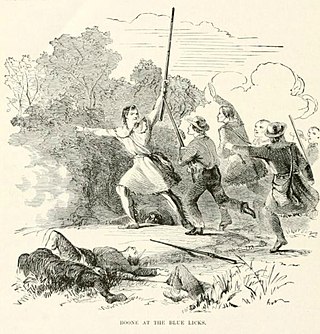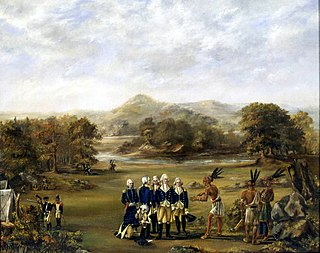
The Battle of Tippecanoe was fought on November 7, 1811, in Battle Ground, Indiana, between American forces led by then Governor William Henry Harrison of the Indiana Territory and tribal forces associated with Shawnee leader Tecumseh and his brother Tenskwatawa, leaders of a confederacy of various tribes who opposed European-American settlement of the American frontier. As tensions and violence increased, Governor Harrison marched with an army of about 1,000 men to attack the confederacy's headquarters at Prophetstown, near the confluence of the Tippecanoe River and the Wabash River.

Tecumseh was a Shawnee chief and warrior who promoted resistance to the expansion of the United States onto Native American lands. A persuasive orator, Tecumseh traveled widely, forming a Native American confederacy and promoting intertribal unity. Even though his efforts to unite Native Americans ended with his death in the War of 1812, he became an iconic folk hero in American, Indigenous, and Canadian popular history.

Lord Dunmore's War, also known as Dunmore's War, was a brief conflict in fall 1774 between the British Colony of Virginia and the Shawnee and Mingo in the trans-Appalachian region of the colony south of the Ohio River. Broadly, the war included events between May and October 1774. The governor of Virginia during the conflict was John Murray, 4th Earl of Dunmore, who in May 1774, asked the House of Burgesses to declare a state of war with the Indians and call out the Virginia militia.

The Battle of Blue Licks, fought on August 19, 1782, was one of the last battles of the American Revolutionary War. The battle occurred ten months after Lord Cornwallis's surrender at Yorktown, which had effectively ended the war in the east. On a hill next to the Licking River in what is now Robertson County, Kentucky, a force of about 50 Loyalists along with 300 indigenous warriors ambushed and routed 182 Kentucky militiamen, who were partially led by Daniel Boone. It was the last victory for the Loyalists and natives during the frontier war. British, Loyalist and Native forces would engage in fighting with American forces once more the following month in Wheeling, West Virginia, during the Siege of Fort Henry.

The Battle of Point Pleasant, also known as the Battle of Kanawha and the Battle of Great Kanawha, was the only major action of Dunmore's War. It was fought on October 10, 1774, between the Virginia militia and Shawnee and Mingo warriors. Along the Ohio River near modern-day Point Pleasant, West Virginia, forces under the Shawnee chief Cornstalk attacked Virginia militiamen under Colonel Andrew Lewis, hoping to halt Lewis's advance into the Ohio Valley. After a long and furious battle, Cornstalk retreated. After the battle, the Virginians, along with a second force led by Lord Dunmore, the Royal Governor of Virginia, marched into the Ohio Valley and compelled Cornstalk to agree to a treaty, which ended the war.

Cornstalk was a Shawnee leader in the Ohio Country in the 1760s and 1770s. His name in the Shawnee language was Hokoleskwa. Little is known about his early life. He may have been born in the Province of Pennsylvania. In 1763, he reportedly led a raid against British American colonists in Pontiac's War. He first appears in historical documents in 1764, when he was one of the hostages surrendered to the British as part of the peace negotiations ending Pontiac's War.

The Northwest Indian War (1785–1795), also known by other names, was an armed conflict for control of the Northwest Territory fought between the United States and a united group of Native American nations known today as the Northwestern Confederacy. The United States Army considers it the first of the American Indian Wars.
The Nickajack Expedition in 1794 was a long-running battle fought from late summer to fall between American frontiersmen and the Chickamauga Cherokee. This Cherokee band had resisted the increasing American encroachment into their territory and raided American settlements in the region.

Benjamin Logan was an American pioneer, soldier, and politician from Virginia, then Shelby County, Kentucky. As colonel of the Kentucky County, Virginia militia during the American Revolutionary War, he was second-in-command of all the trans-Appalachian Virginia. He became a politician and help secure statehood for Kentucky. His brother, John Logan, who at times served under him in the militia and replaced him as delegate, became the first state treasurer of Kentucky.

The western theater of the American Revolutionary War (1775–1783) was the area of conflict west of the Appalachian Mountains, the region which became the Northwest Territory of the United States as well as what would become the states of Arkansas, Kentucky, Louisiana, Missouri, and Tennessee. The western war was fought between American Indians with their British allies in Detroit, and American settlers south and east of the Ohio River, and also the Spanish as allies of the latter.

The siege of Boonesborough was a military engagement which took place in September 1778 during the American Revolutionary War. On September 7, Shawnee chief Blackfish, who was allied to the British, led an attack on the Kentucky settlement of Boonesborough. Months before the battle, Blackfish had captured and adopted Daniel Boone, the founder of Boonesborough. Boone escaped the Shawnees in time to lead the defense of the settlement. Blackfish's siege was unsuccessful and was lifted after eleven days. Boone was then court-martialed by fellow officers who suspected him of harboring Loyalist sympathies. He was acquitted, but soon left the settlement.

The Cherokee–American wars, also known as the Chickamauga Wars, were a series of raids, campaigns, ambushes, minor skirmishes, and several full-scale frontier battles in the Old Southwest from 1776 to 1794 between the Cherokee and American settlers on the frontier. Most of the events took place in the Upper South region. While the fighting stretched across the entire period, there were extended periods with little or no action.
Snake was the English language name of two Shawnee leaders prominent in the history of the Ohio Country: Peteusha and Shemanetoo. They were both commonly referred to as "Snake" in historical records, or by variations such as "Black Snake" or "Captain Snake," so it is often difficult to determine which individual was being referred to. On a number of occasions, the two Snakes both signed a letter or appeared together, so it is clear they were two different people. There may have been additional Shawnees called "Snake," further complicating the matter. According to historian John Sugden, "it is unlikely if the biographies of these chiefs will ever be completely disentangled."
Moluntha, also spelled Molunthe, Melonthe, and Malunthy, was a prominent civil chief of the Shawnee people in the 1780s. He was murdered by a Kentucky soldier at the outset of the Northwest Indian War (1785–1795).

The Harmar campaign was an attempt by the United States Army to subdue confederated Native Americans nations in the Northwest Territory that were seen as hostile in Autumn 1790. The campaign was led by General Josiah Harmar and is considered a significant campaign of the Northwest Indian War. The campaign ended with a series of battles on 19–22 October 1790 near the Fort Miami and Miami village of Kekionga. These were all overwhelming victories for the Native Americans and are sometimes collectively referred to as Harmar's Defeat.

Tecumseh's confederacy was a confederation of indigenous peoples of the Great Lakes region of North America that began to form in the early 19th century around the teaching of Tenskwatawa, called The Prophet by his followers. The confederation grew over several years and came to include several thousand warriors. Shawnee leader Tecumseh, the brother of The Prophet, developed into the leader of the group as early as 1808. Together, they worked to unite the various tribes against the European settlers who had been crossing the Appalachian Mountains and settling on their land.

St. Clair's defeat, also known as the Battle of the Wabash, the Battle of Wabash River or the Battle of a Thousand Slain, was a battle fought on 4 November 1791 in the Northwest Territory of the United States. The U.S. Army faced the Western Confederacy of Native Americans, as part of the Northwest Indian War. It was "the most decisive defeat in the history of the American military" and its largest defeat ever by Native Americans.
John Logan was a military officer, farmer and politician from Virginia who became a pioneer in and helped found the state of Kentucky. He served under his brother, Benjamin during Lord Dunmore's War in 1774, then both moved to what was then called Kentucky County, Virginia. Logan took part in several expeditions against the Shawnee, including some led by Daniel Boone, John Bowman, and George Rogers Clark. After Kentucky County was split into three counties, Logan and his brother at various times represented Lincoln in the Virginia House of Delegates, and John Logan also represented that county at the Virginia Ratification Convention in 1788.
Hugh McGary was an Irish-born American military officer and landowner who was the founder of McGary Station in present-day Oregon, Kentucky.
Kekewepelethy, also known as Captain Johnny, was the principal civil chief of the Shawnees in the Ohio Country during the Northwest Indian War (1786–1795). He first came to prominence during the American Revolutionary War (1775–1783), in which he, like most of his fellow Mekoche Shawnees, initially sought to remain neutral. He joined the war against the United States around 1780, moving to Wakatomika, a Shawnee town known for its militant defense of the Ohio Country.














